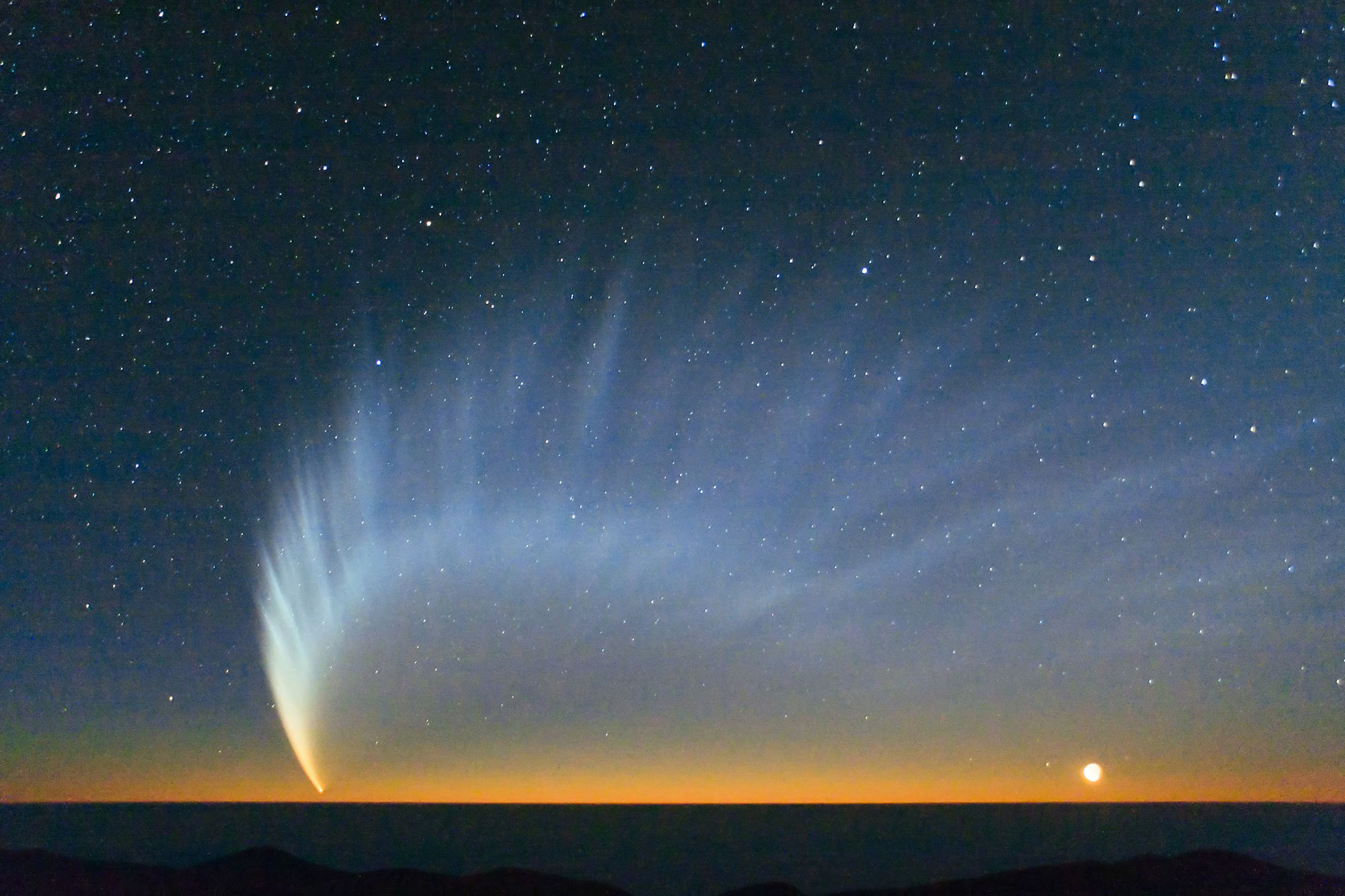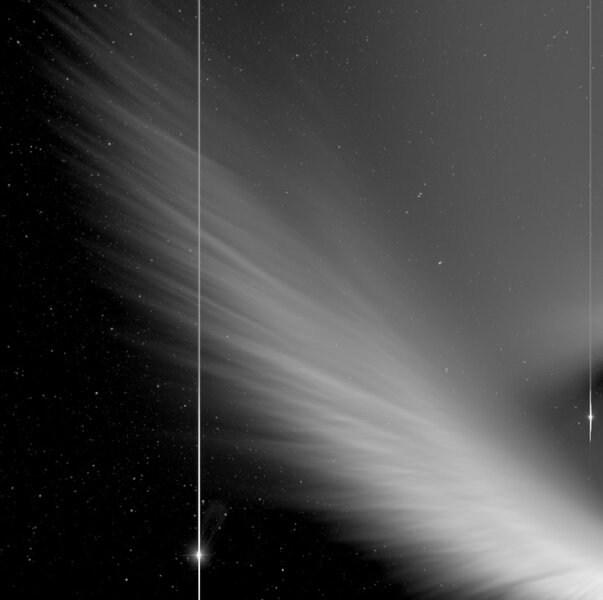Create a free profile to get unlimited access to exclusive videos, sweepstakes, and more!
The feathery, dusty, and spectacular tail of Comet McNaught

Comets are mysterious little buggers, aren’t they?
Visitors from deep space, the brightest ones sometimes fall from well outside Neptune’s orbit, and warmed by the Sun throw out a long tail of dust and gas, giving them their iconic appearance. Most are so faint you need a big telescope to see them, but others get bright enough to see easily with the naked eye.
Before the invention of the telescope, these objects would appear suddenly in the sky, interpreted as harbingers of change (good or bad, depending on your point of view). Now, with telescopes on Earth and mounted on spacecraft — even with spacecraft that have flown by or even orbited comets — we’ve learned a vast amount about them.
But they still hold their secrets. Their behavior can be as odd as it is beautiful, and it’s not always easy to explain.
Enter the comet C/2006 P1 (McNaught). This beastie whipped around the Sun in January 2007, and was bright enough to spot easily with the naked eye — it got so bright that I myself saw it in broad daylight.
It also had a truly incredible tail, easily many millions of kilometers long. The Ulysses spacecraft could still measure the effect of the tail on the solar wind more than 250 million kilometers from the comet itself!
But this was no ordinary comet tail — as it rounded the Sun, the tail suddenly started emitting spectacular long, straight features, making it look like a plume from some sort of cosmic bird. These rare structures are called striae, and until recently they weren’t well understood. It was known they were composed of dust — microscopic grains of rocky silicates, so small they’re similar to smoke — but it wasn’t clear how they formed at all, or how grain size affects their shape, or how the Sun affects their behavior.
Now, a decade later, scientists may have an explanation.
A little background: Comets are lumps of rock and ice that orbit the Sun, some small at tens of meters across and others huge at dozens of kilometers wide. The ice can be frozen water, carbon monoxide, carbon dioxide, ammonia, and other things we think of as gases here on the surface of Earth. The rock comes in all shapes and sizes; we’ve seen boulders on comets as well as much smaller rocks, pebbles, and even those aforementioned teeny-tiny grains of dust.
If a comet gets close enough to the Sun the ice turns into a gas that surrounds the solid nucleus, forming a fuzzy coma (which together are called the head). Ultraviolet light from the Sun zaps the gas flowing out from the comet, ionizing it (stripping one or more electrons from the molecules and atoms). This gives the gas particles an electric charge, which makes them highly susceptible to the solar wind — subatomic particles streaming from the Sun at high speed — which blows them straight back, away from the Sun, forming the ion tail. This can be bluish or green, depending on what gases are in the tail.
The coma also has dust in it, carrying off by the expanding gas. The pressure from sunlight pushes on the small grains of dust, blowing them out from the head to form the dust tail — this usually looks yellowish due to reflected and reddened sunlight.
Striae somehow form as the dust leaves the comet head, sprouting off the tail like barbs off a shaft in a bird feather. Two ideas came out in the 1990s to explain them. In one, dust comes off the comet in bursts. Sunlight then spontaneously and rapidly breaks up the dust particles, so you get big ones and little ones. The smaller ones are more affected by sunlight pressure (this is an extremely weak force, so the smaller grains, with less mass, get pushed on it more), so you get mass segregation: Heavier grains stay near the comet, while progressively lighter ones get blown farther out. This would naturally create long linear features.
The other idea is that the grains separate from the comet but remain mixed even as they float away. Then, over time, sunlight breaks them down, segregating them by mass. The difference between the two ideas is subtle, but has ramifications for how sunlight affects the dust grains and the detailed process for how tails form. It even affects the reverse process: How dust can clump together to form asteroids and planets, so it has implications for how we think the solar system formed.
New research using spacecraft observations of McNaught shows that the second idea is more likely to be the correct one. That’s because they saw an interesting phenomenon: Around Jan. 13, 2007, the striae suddenly got disrupted, changing them from nice, clean lines to a more fan-like, interleaving shape. It turns out this is when the comet crossed a region of space called the heliospheric current sheet. The Sun has a huge magnetic field which affects the thinly spread gas between the planets. This stuff flows in an electric current around the Sun, driven by the solar magnetism. The heliospheric current sheet is where the magnetic polarity switches from positive to negative, sort of like how halfway around a bar magnet you’re more affected by the north pole of the magnet than the south.
The upshot is that this changes how electrically charged particles flow, and that’s clearly what affected the striae in McNaught’s tail (dust, like gas, can get electrically charged by ultraviolet sunlight). This was observed in the data from NASA’s STEREO and SOHO Sun-observing spacecraft. The scientists found that the disruption was strongest in the parts nearest the comet, while farther out along the striae the effect was lessened. If the first idea (dust disruption near the comet) were correct, you’d see the finest grains farthest from the comet, and they would be the most susceptible to disruption from the current sheet. But that’s not what was seen. This then favors the second idea, where the dust is segregated but not nearly as much, and remains mixed throughout the striae.
Other effects also come into play, shaping the overall structure, but the important bit is how the dust behaves once it leaves the comet, and how the Sun affects that behavior. Of course, there’s tons more to be learned and understood, but it’s nice that old data from an event over a decade ago can be analyzed to distinguish between two competing ideas.
That’s good, because McNaught is gone. Its orbit indicated it came from deep, deep space, way beyond Neptune, and the gravity of the planets affected its trajectory enough that it’s now on a roughly 100,000-year orbit. So yeah, this was really our only chance to see it.
But there will be more. McNaught was a rare and exceptional comet, but not unique. There will be others, and we have more and better ways to study them all the time. Hopefully, when the next big comet decides to come by and shake its tail feathers, we’ll be that much more ready to understand how and why.




























